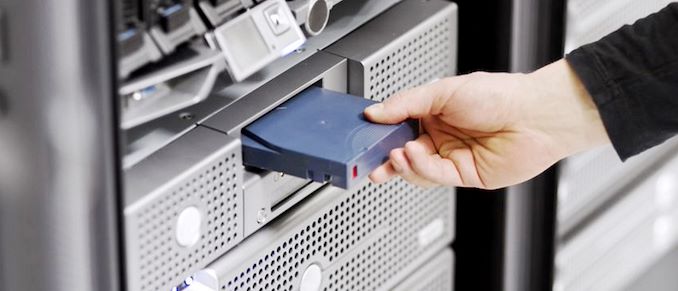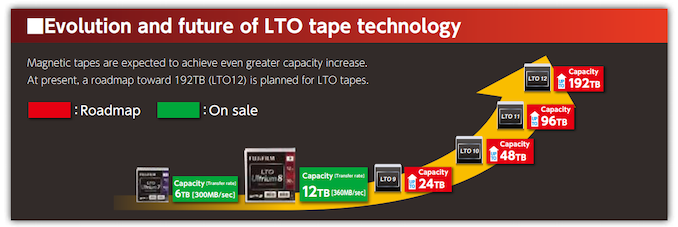400 TB Storage Drives In Our Future: Fujifilm
by Dr. Ian Cutress on June 30, 2020 8:00 AM EST
One of the two leading manufacturers of tape cartridge storage, FujiFilm, claims that they have a technology roadmap through to 2030 which builds on the current magnetic tape paradigm to enable 400 TB per tape.
As reported by Chris Mellor of Blocks and Files, Fujifilm points to using Strontium Ferrite grains in order to enable an areal data density on tape of 224 Gbit-per-square-inch, which would enable 400 TB drives. IBM and Sony have already demonstrated 201 Gbit-per-square-inch technology in 2017, with a potential release of the technology for high volume production in 2026. Current drives are over an order of magnitude smaller, at 8 Gbit-per-square-inch, however the delay between research and mass production is quite significant.
Strontium Ferrite would replace Barium Ferrite in current LTO cartridges. Strontium sits on a row above Barium in the periodic table, indicating a much smaller atom. This enables for much smaller particles to be placed into tracks, and thankfully according to Fujifilm, Strontium Ferrite exhibits properties along the same lines as Barium Ferrite, but moreso, enabling higher performance while simultaneously increasing particle density.
In standard LTO nomenclature, we are currently on LTO-8 where the drives have 12 TB raw capacity. Recent generational increases in LTO tend to double the capacity, so we’re looking at LTO-13 for 384 TB drives. Mellor indicates that there seems to be an average 2.5 years between commercialization of successive LTO drive standards, which leads to the following table:
| LTO Generation Progression | |||||||
| AnandTech | Standard | Retail | Length | Raw Cap. |
Speed MB/s |
Time to fill |
Material |
| LTO-1 | 2000 | 609 m | 0.1 TB | 20 | 1h23 | MP | |
| LTO-2 | 2003 | 609 m | 0.2 TB | 40 | 1h23 | MP | |
| LTO-3 | 2005 | 680 m | 0.4 TB | 80 | 1h23 | MP | |
| LTO-4 | 2007 | 820 m | 0.8 TB | 120 | 1h51 | MP | |
| LTO-5 | 2010 | 846 m | 1.6 TB | 140 | 3h10 | MP | |
| LTO-6 | 2012 | 846 m | 2.5 TB | 160 | 4h20 | MP/BaFe | |
| LTO-7 | 2010 | 2015 | 960 m | 6.0 TB | 300 | 5h33 | BaFe |
| LTO-8 | 2010 | 2017 | 960 m | 12.0 TB | 360 | 9h16 | BaFe |
| LTO-9 | 2014 | 2020 | 24.0 TB | *708 | *9h25 | BaFe | |
| LTO-10 | 2014 | *2022 | 48 TB | *1100 | *12h07 | Ba/Sr Fe | |
| LTO-11 | 2017 | *2025 | 96 TB | *1800 | *14h49 | SrFe | |
| LTO-12 | 2017 | *2027 | 192 TB | *2400 | *22h13 | SrFe | |
| LTO-13 | *2021 | *2030 | *384 TB | SrFe? | |||
| LTO-14 | *2021 | *768 TB | |||||
| *Unconfirmed/estimated | |||||||
Current generation LTO-8 cartridges take at least 9h16 to fill, with predicted speeds on future drives increasing that even further. Current LTO specifications go up to LTO-12, and so 400 TB would thus come in the LTO-13 generation.
Fujifilm states that 400 TB is the limit of Strontium Ferrite, indicating that new materials would be needed to go beyond. That said, we are talking about only 224 Gbit-per-square-inch for storage, which compared to mechanical hard disks going beyhind 1000 Gbit-per-square-inch today, there would appear to be plenty of room at the top if the technologies could converge.
Prices for current LTO-8 tape are the lowest out of all storage media. Depending on volume, prices around 0.8-1 cent per gigabyte is fairly common. Currently only Sony and Fujifilm are licencees to create LTO-8 media, however other companies such as HPE and IBM resell models under their own brand.
Source: Blocks and Files












32 Comments
View All Comments
shadowjk - Sunday, July 5, 2020 - link
I imagine they're very much treated like write-once and (hopefully) read-never kind of storage.I wouldn't be surprised if there was a hdd or SSD to which the file was first prepared before copy to tape. And that's the stage at which I would add redundancy.
s.yu - Wednesday, July 8, 2020 - link
A RAID5 of LTO-10 definitely sounds far superior(in basically every metric except R/W and write cycles) to RAID 5 of HDDs with matching capacity(which would still constitute a small server in 2022) if used specifically for media archiving.